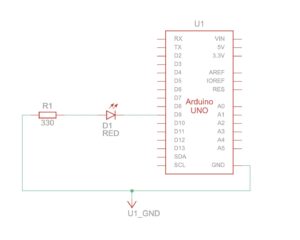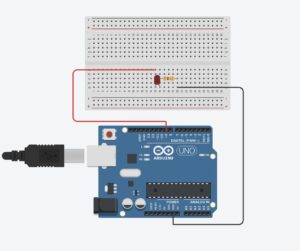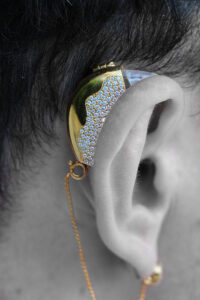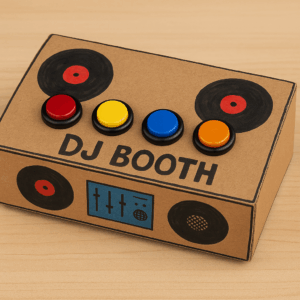Exercise 1: Arduino to P5 Communication
For this exercise, we used a potentiometer as the analog sensor. The potentiometer controls the ellipse’s position on the horizontal axis in the P5 sketch. When you turn it one way, the ellipse moves to the right, turning it the other way causes it to move left.
We added a little text at the top of the sketch that displays the sensor value. As the value increases, the ellipse moves to the right, and vice versa.
Arduino:
void loop() {
potentiometerValue = analogRead(potentiometerPin); // reads sensor value (0–1023)
// Send value to p5 via serial as a line of text
Serial.println(potentiometerValue);
delay(20);
}
P5:
// read sensor value from Arduino
let data = port.readUntil("\n");
if (data.length > 0) {
sensorValue = int(trim(data)); // convert from string to number
}
// map potentiometer range (0–1023) to screen width
let x = map(sensorValue, 0, 1023, 0, width);
let y = height / 2;
//draws ellipse
ellipse(x, y, 50, 50);
Exercise 2: P5 to Arduino Communication
Here, we used the keyboard arrow keys to change the LED brightness. Pressing the right arrow increases the brightness, and the left arrow decreases it.
Arduino:
void loop() {
if (Serial.available() >= 0) {
brightness = Serial.parseInt();
brightness = constrain(brightness, 0, 255);
analogWrite(ledPin, brightness);
}
}
P5:
function draw() {
background(240);
if (!port.opened()) {
text("Disconnected - press button to connect", 20, 80);
} else {
text("Connected - use arrow keys to adjust brightness", 20, 80);
text("Brightness: " + sendToArduino, 20, 120);
// Send the brightness value to Arduino
port.write(sendToArduino + "\n");
}
}
function keyPressed() {
if (keyCode === LEFT_ARROW) {
sendToArduino -= 10;
} else if (keyCode === RIGHT_ARROW) {
sendToArduino += 10;
}
sendToArduino = constrain(sendToArduino, 0, 255);
}
Exercise 3: Bi-directional Communication
For the Arduino to P5 communication, the potentiometer acts like the “wind” in the gravity/wind example. As you turn it, the ball gets pushed left or right depending on the mapped value.
For the P5 to Arduino communication, every time the ball hits the bottom and bounces, it triggers the LED to briefly turn on and then off, so the LED flashes in sync with each bounce.
Arduino:
void loop() {
// Read analog sensor
sensorValue = analogRead(sensorPin);
// Send sensor value to P5
Serial.println(sensorValue);
// Check for bounce signal from P5
if (Serial.available() > 0) {
int bounce = Serial.read();
if (bounce == 1) {
digitalWrite(ledPin, HIGH);
delay(100);
digitalWrite(ledPin, LOW);
}
}
delay(50);
}
P5:
// Read analog sensor value from Arduino
if (port.available() > 0) {
sensorValue = int(port.read());
wind.x = map(sensorValue, 0, 1023, -2, 2); // Map sensor to wind strength
}






